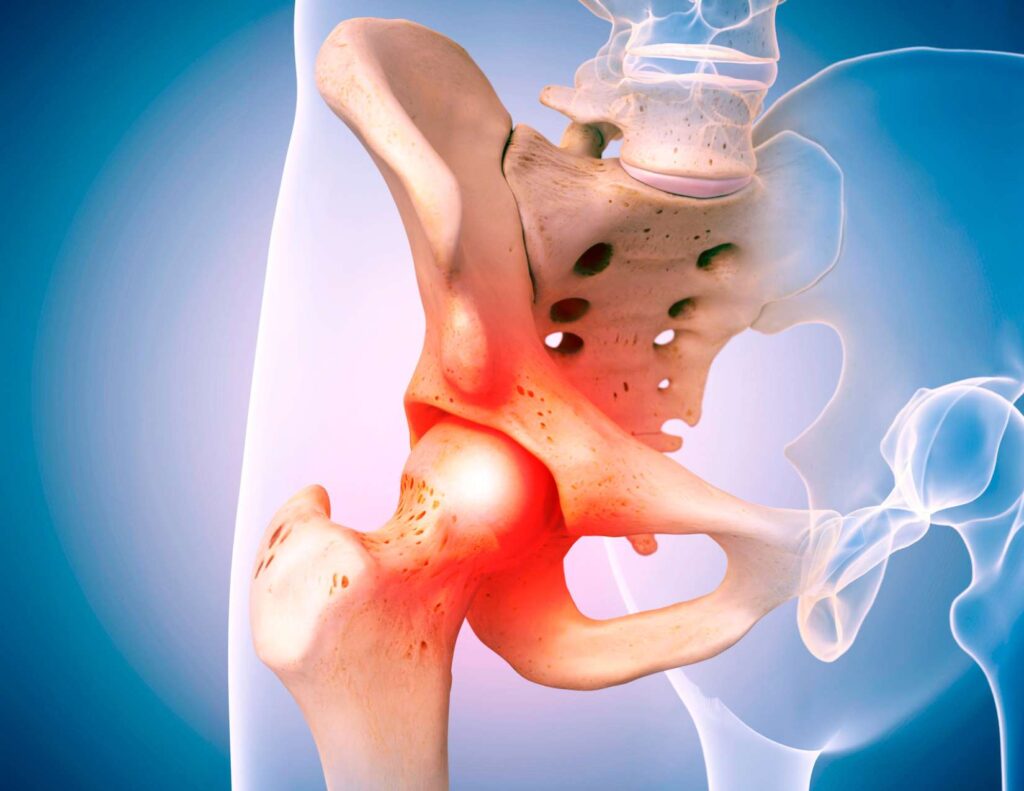Find Out What Causes Sciatic Pain in Hip Joints
Are you experiencing sciatic pain in your hip joint? This is a discomfort that’s all too familiar for many people. Sciatic pain, a sharp and throbbing sensation that radiates from your lower back to your hip joint and down your leg, is more than just a minor inconvenience – it’s a debilitating condition that can significantly impact your quality of life. But what causes this pain and, more importantly, how can you alleviate it?
In this article, we delve into the mystery of sciatica pain, exploring its causes, symptoms, and effective management strategies. Whether you’re a long-time sufferer or a concerned loved one, this article provides valuable insights to help you navigate the complex world of sciatic pain in hip joints.

Table of Contents
Introduction to sciatic pain in hip joints
Sciatic pain in the hip joint can be a debilitating condition that affects many individuals. It is important to understand the complexities of this condition in order to effectively manage and treat it. In this article, we will delve into the anatomy of the hip joint and the sciatic nerve, explore the causes of sciatic pain in the hip joint, discuss the symptoms and signs to look out for, and explore the various treatment options available. Whether you are currently experiencing sciatic pain or simply want to learn more about this condition, this article will provide you with the knowledge you need to navigate the complexities of sciatic pain in the hip joint.
The anatomy of the hip joint and the sciatic nerve
To understand sciatic pain in the hip joint, it is essential to have a basic understanding of the anatomy of the hip joint and the sciatic nerve. The hip joint is a ball-and-socket joint that connects the femur (thigh bone) to the pelvis. It is surrounded by a complex network of muscles, tendons, and ligaments that work together to provide stability and mobility to the joint.
The sciatic nerve is the longest nerve in the human body and originates through the nerve roots from the spine in the lumbar spine, running down through the buttocks and into the legs. It is responsible for transmitting signals between the brain and the lower body. When the sciatic nerve becomes compressed or irritated, it can cause pain, numbness, and tingling sensations in the hip joint and down the leg.

Causes of sciatic pain in hip joints
There are several potential causes of sciatic pain in the hip joint. One common cause is a herniated disc, which occurs when the gel-like center of a spinal disc protrudes through a tear in the outer layer. This can put pressure on the sciatic nerve and result in pain in the hip joint. A “pinched nerve” is another cause of sciatic pain in the hip joint. This occurs when a nerve root is compressed or squeezed between two bones, usually in the spine. This can lead to low back pain and numbness that radiates along the path of the sciatic nerve into the hip joint and down towards the affected leg.
Another potential cause of sciatic pain in the hip joint is piriformis syndrome. The piriformis muscle is located deep within the buttocks and runs directly over the sciatic nerve. When this muscle becomes tight or spasms, it can compress the sciatic nerve and cause pain in the hip joint.
Other potential causes of sciatic pain in the hip joint include spinal stenosis, which is a narrowing of the spinal canal, and degenerative disc disease, which is the gradual deterioration of the spinal discs. In some cases, sciatic pain in the hip joint may be caused by trauma or injury, such as a fall or a car accident.
Symptoms and signs of sciatic pain in hip joints
Sciatic pain in the hip joint can manifest in a variety of ways. The most common symptoms of sciatica is pain that radiates from the lower back, through the buttocks, and down the back of your leg. This lower back pain can range from a mild ache to a sharp, shooting sensation. Some individuals may also experience numbness, tingling, or weakness in the hip joint and leg.
In addition to pain, individuals with sciatic nerve pain in the hip joint may also experience difficulty in their lower extremities. This could cause leg pain and problems with walking or standing for long periods of time. They may find that certain movements, such as bending or twisting, exacerbate their symptoms. It is important to pay attention to these symptoms and seek medical attention if they persist or worsen over time.
Diagnosing sciatic pain in the hip joint
If you are experiencing symptoms of sciatic pain in the hip region, it is important to consult with a healthcare professional for an accurate diagnosis. The diagnostic process typically begins with a thorough medical history and physical examination. Your healthcare provider may ask you about your symptoms, when they started, and what activities or movements exacerbate them.
In addition to a physical examination, your healthcare provider may order diagnostic tests, such as an X-ray, MRI, or CT scan, to get a better look at the structures within the hip joint. These tests can help identify any underlying conditions or abnormalities such as the compression of the sciatic nerve, a herniated disk or other spinal cord issues.

Treatment options for sciatic pain in the hip joint
Once a diagnosis of sciatic pain in the hip joint has been made, there are several treatment options available. The appropriate treatment will depend on the underlying cause of your pain and the severity of your symptoms.
Non-surgical treatments
Non-surgical treatments are often the first line of defense against sciatic pain in the hip joint. These conservative treatments aim to alleviate pain, reduce inflammation, and improve mobility. Some common non-surgical treatment options include:
- Physical therapy: A physical therapist can provide exercises and stretches to strengthen the muscles around the hip joint, improve flexibility, and reduce pain.
- Medications: Over-the-counter pain relievers, such as non-steroidal anti-inflammatory drugs (NSAIDs), can help reduce pain and inflammation. In some cases, your healthcare provider may prescribe stronger medications, such as muscle relaxants or opioids, to manage severe pain.
- Injections: Corticosteroid injections can be administered directly into the hip joint to reduce inflammation and provide temporary pain relief to aide in the healing process.
Surgical treatments
In more severe cases (which is very rare) of sciatic pain in the hip joint, surgical intervention may be necessary. Surgery is typically reserved for individuals who have not found relief with non-surgical treatments or who have an underlying condition that requires surgical correction. Some common surgical treatments for sciatic pain in the hip joint include:
- Discectomy: A discectomy involves removing a portion of a herniated disc that is compressing the sciatic nerve.
- Piriformis release: This surgical procedure involves releasing the piriformis muscle to relieve pressure on the sciatic nerve.
- Spinal fusion: In cases where spinal stenosis or degenerative disc disease is causing sciatic pain in the hip joint, a spinal fusion may be performed to stabilize the affected area of the spine.
Home remedies and self-care for sciatic pain in the hip joint
In addition to medical treatments, there are several home remedies and self-care techniques that can help manage sciatic pain in the hip joint. These techniques can be used in conjunction with medical treatments or as a stand-alone approach for milder cases of sciatic pain. Some effective home remedies and self-care techniques include:
- Heat and cold therapy: Applying a heating pad or ice pack to the affected area can help reduce inflammation and alleviate pain.
- Gentle stretching: Performing gentle stretches and exercises that target the hip joint and lower back can help improve flexibility and reduce pain.
- Maintaining good posture: Sitting and standing with proper posture can help alleviate pressure on the sciatic nerve and reduce pain.
- Massage: Massages and pressure points can be used to target tight muscles in the hip and lower back, reducing pain and inflammation.
- Acupuncture: Acupuncture for sciatica involves inserting needles into specific points along the body that correspond with sciatic nerve pain. It may help reduce symptoms and increase mobility.
- Herbal remedies: Herbal remedies for sciatica such as turmeric or willow bark extract may be used to reduce inflammation and alleviate pain.

Prevention and management of sciatic pain in the hip joint
While it may not always be possible to prevent sciatic pain in the hip joint, there are steps you can take to reduce your risk and manage your symptoms. Some effective prevention and management strategies include:
- Regular exercise: Engaging in regular physical activity can help strengthen the muscles around the hip joint and reduce the risk of injury.
- Maintaining a healthy weight: Excess weight can put added stress on the hip joint and increase the risk of sciatic pain. Maintaining a healthy weight can help reduce this risk.
- Using proper lifting techniques: When lifting heavy objects, it is important to use proper lifting techniques to avoid straining the muscles and putting pressure on the sciatic nerve.
- Using ergonomic furniture: Sitting for long periods of time can put pressure on the sciatic nerve and lead to pain. Ergonomic furniture can help reduce this risk by providing support and cushioning for the body.
- Taking breaks throughout the day: Taking regular breaks throughout the day can help give your muscles a chance to rest and give you immediate relief for sciatica pain.
When to seek medical attention for sciatic pain in the hip joint
While many cases of sciatic pain in the hip joint can be managed with home remedies and self-care techniques, there are instances where it is considered a medical emergency. You should seek medical attention if:
- Your sciatica symptoms are severe or worsening
- You are experiencing bowel or bladder dysfunction “cauda equina syndrome”
- You have difficulty controlling your leg movements
- Your pain is accompanied by fever, chills, or unexplained weight loss
Conclusion
Sciatic pain in the hip joint can be a complex and debilitating condition. By understanding the anatomy of the hip joint and the sciatic nerve, recognizing the causes and symptoms of sciatic pain, and exploring the various treatment options available, you can better navigate the complexities of this condition. Whether you choose non-surgical treatments, opt for surgical intervention, or implement home remedies and self-care techniques, the goal is to alleviate pain, reduce inflammation, and improve mobility. Remember to consult with a healthcare professional for an accurate diagnosis and personalized treatment plan. With the right approach, you can effectively manage and treat sciatic pain in the hip joint, restoring comfort and quality of life!







